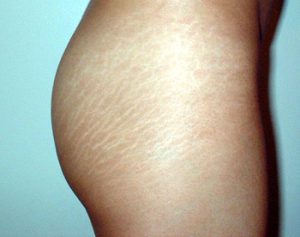Stretch marks come in all different colors—red, brown, and white are the most common. They can affect both men and women, and can occur anywhere on your body. They happen because of a (fairly) rapid increase in size of the body where your skin just cannot keep pace. Pregnancy, puberty and rapid weight gain can cause stretch marks.
Why Stretch Marks Have Different Colors

Why the different colors, then? The reason is due to both the underlying color of your skin and the age of the stretch marks. New stretch marks tend to be red or brown whereas older ones fade to white.
How Laser Treatments Can Help
At Celibre Medical, we have many different help with the color and texture of your stretch marks. We think it is important for you to know, however, that since stretch marks are a type of scar, the goal of any laser therapy is to improve the way they look, not remove them completely.
Why White Stretch Marks Are Harder to Treat
Red, brown and textured stretch marks are the easiest to treat, because our lasers are good at targeting excessive blood vessels (red), pigmentation (brown) and lost collagen (textured) that cause them to look that way. White stretch marks are a a different story. Hypopigmentation is the medical term for lightened skin or loss of skin pigmentation. White stretch marks are the hardest type to treat.
Limitations of Laser Treatments for White Stretch Marks
Although we can sometimes improve the appearance of light stretch marks, this is associated with improving the texture of indented stretch marks at the same time. For flat, white stretch marks, we do not have an option because lasers cannot add color to the skin.
Most Common FAQs
1. What causes stretch marks?
Stretch marks form as skin scars after rapid stretching of the skin, such as during pregnancy, puberty, or rapid weight gain. Over time, older stretch marks lose pigmentation and fade from red or brown to white.
2. Can Stretch marks be completely removed?
No, Stretch marks are permanent scars. Laser treatments and other therapies can improve their texture and appearance, but they cannot restore lost color.
3. Why are red and brown stretch marks easier to treat than white ones?
Red stretch marks respond to lasers that target excessive blood vessels, brown marks respond to pigmentation-targeting lasers, and textured marks respond to collagen-stimulating treatments. White stretch marks lack pigment, making them harder to treat with lasers.
4. Are there ways to prevent stretch marks from forming?
Yes. Maintaining healthy skin through hydration, controlling rapid weight changes, and using supportive creams or oils during periods of growth (pregnancy, puberty) may help reduce the risk of new stretch marks.
5. What treatments are available for white stretch marks?
While color restoration isn’t possible, treatments like laser therapy or microneedling can improve the texture of indented white stretch marks, making them less noticeable.
Stretch marks are difficult to treat, but there are options available. Call today to see if we can help improve your stretch marks.

